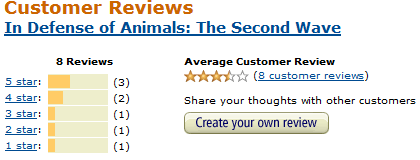
Image Credit:
Amazon.com, Inc.
http://www.amazon.com/In-Defense-Animals-Second-Wave/product-reviews/1405119411/ref=dp_top_cm_cr_acr_txt?ie=UTF8&showViewpoints=1
My Rhetoric 309K class, “Rhetoric of Animal Rights,” features three unequal units respectively emphasizing description, analysis, and production of argument. The second unit culminates in a book review of a text germane to the course topic.
I like book reviews for a number of reasons, but mainly because it shows how rhetorical description and evaluation translate into “real world” texts that have audiences bigger, more diverse, and more diversely motivated than the teacher at the front of the room. It makes the enterprise of rhetorical analysis, I think, feel like less of a purely formal academic exercise. (I’ve heard criticism of my philosophy here, suggesting that it devalues the uniqueness of the classroom and value of academic writing, but that is another post entirely.)
Another feature of book reviews is the sheer availability of models: from the high-style “review essays” one finds in select academic journals to conventional academic reviews and newspaper and magazine versions of the same, there has long existed a wealth of quickly and easily accessible online resources for starting a conversation about what an evaluative book review looks like.
These have been augmented in recent years by the ubiquity of user reviews on sites like Amazon and Goodreads. The immense volume of these (sometimes in the hundreds or thousands for a single work) allows for a kind of investigation that we might typically not have assigned to undergrads in lower-division courses: the reception study.
Because star-rating reviews on both sites can be viewed as both means and distributions, each accompanied by a reader’s written opinion, students are given instant exposure to both quantitative and qualitative cross-evaluations of any given text. In addition to getting myriad examples of the huge number of ways that readers slice and dice the texts they evaluate, they can take two additional points away. First, the onus of having to perform rhetorical analysis in a vacuum is lifted. Many students tend to exhibit an unhealthy reverence for the printed word, thinking that they have little constructive to add to the opinions of a writer who, despite whatever faults, has achieved publication from others—something most of the students will have not thus far done. By studying a text’s reception, they can see that amateur reviewers can and do bring cogent observations and judgments to bear on professional writers.
Second, the high readership volume explicitly commercial context of these reviewing services lets students understand the immediate pragmatic payoffs of engaging in criticism—it is read by a public, generates positive and negative replies, is evaluated for usefulness, and, ultimately, may sway the opinion of an actual person about to spend money on something. The reward for shrewd analysis is seldom so blessedly immediate or concrete.
In a world in which Netflix and Facebook are assiduously individualizing what we are exposed to through the use of personalization algorithms, it is important that students realize that they get something less obvious than tailored content in exchange for the loss of privacy: a critical voice that can and will be heard by others who are themselves making very practical quotidian decisions about whether to read a book, buy an album, or visit a restaurant. Using online reviews as a reading tool in the classroom helps students to understand that humans evaluate things as social beings, and that, even if they are not yet sold on the power of their individual voices, as members of a critical community they have the power to inform, persuade, and entertain other members of the public—the very goals of a rhetorical education.

